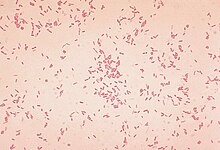Aeromonas
| Aeromonas | |
|---|---|

| |
| Aeromonas hydrophila | |
| Scientific classification | |
| Domain: | Bacteria |
| Phylum: | Proteobacteria |
| Class: | Gammaproteobacteria |
| Order: | Aeromonadales |
| Family: | Aeromonadaceae |
| Genus: | Aeromonas Stanier 1943 |
| Species | |
|
A. aquariorum | |
Aeromonas is a genus of Gram-negative, facultative anaerobic, rod-shaped bacteria that morphologically resemble members of the family Enterobacteriaceae. Most of the 14 described species have been associated with human diseases. The most important pathogens are A. hydrophila, A. caviae, and A. veronii biovar sobria. The organisms are ubiquitous in fresh and brackish water.[2]
They group with the gamma subclass of the Proteobacteria.[3]
Two major diseases associated with Aeromonas are gastroenteritis and wound infections, with or without bacteremia. Gastroenteritis typically occurs after the ingestion of contaminated water or food, whereas wound infections result from exposure to contaminated water. In its most severe form, Aeromonas spp. can cause necrotizing fasciitis, which is life-threatening, usually requiring treatment with antibiotics and even amputation.[4]
Although some potential virulence factors (e.g. endotoxins, hemolysins, enterotoxins, adherence factors) have been identified, their precise roles are unknown. Aeromonas species cause:
- Diarrheal disease in otherwise healthy individuals
- Wound infections
- Opportunistic systemic disease in immunocompromised patients
Caution about differential diagnosis[]
If automated machines are not using the most updated database, Elizabethkingia meningoseptica may be mistaken for A. salmonicida.
Association with human diarrhea and human intestinal infections[]
Literature exists on this subject, but many papers have not adequately studied the causal role of the Aeromonas strain(s) that were isolated from the cases that were studied. The presence of an Aeromonas strain in a fecal specimen does not prove or even imply that the strain was causing the diarrhea. Gastrointestinal disease in children is usually an acute, severe illness, whereas that in adults tends to be chronic diarrhea. Severe Aeromonas gastroenteritis resembles shigellosis, with blood and leukocytes in the stool. Acute diarrheal disease is self-limited, and only supportive care is indicated in affected patients.
Wound infection[]
Wound infections are the second-most common type of human infection associated with Aeromonas.[5] They are associated with penetrating wounds or abrasions that place the wound in contact with fresh water or soil.[5]
Medicinal leeches[]
Aeromonas species are endosymbionts of Hirudo medicinalis, a species of leech that is FDA-approved for use in vascular surgery such as skin grafts and flaps.[6][7] Aeromonas aides leeches in digesting blood meals.[8] H. medicinalis used after surgery has led to Aeromonas infections, most commonly with A. veronii.[6] This can present as a local cellulitis, though can progress to subcutaneous abscess and sepsis.[6]
Respiratory infection[]
Aeromonas species have also been associated with pneumonia after near-drowning events, especially in fresh water.[9] Most commonly, this has been reported with A. hydrophila, though the ability of clinical laboratories to correctly identify species of Aeromonas has been limited.[9] Aeromonas pneumonia due to episodes of near-drowning are frequently complicated by bacteremia and death.[9]
Antimicrobial therapy[]
Aeromonas species are resistant to penicillins, most cephalosporins, and erythromycin. Ciprofloxacin is consistently active against their strains in the U.S. and Europe, but resistant cases have been reported in Asia.
Etymology[]
The name Aeromonas derives from:
Greek aer, aeros (ἀήρ, ἀέρος), air, gas; and -monas|monas (μονάς), unit, monad; gas(-producing) monad.[10]
Members of the genus Aeromonas can be referred to as aeromonads (viz. trivialisation of names).
References[]
- ^ a b c d e Parte, A. C. "Aeromonas". LPSN.
- ^ Graf J (editor). (2015). Aeromonas. Caister Academic Press. ISBN 978-1-908230-56-0.
- ^ Martinez-Murcia AJ, Benlloch S, Collins MD (July 1992). "Phylogenetic interrelationships of members of the genera Aeromonas and Plesiomonas as determined by 16S ribosomal DNA sequencing: lack of congruence with results of DNA-DNA hybridizations". International Journal of Systematic and Evolutionary Microbiology. 42 (3): 412–21. doi:10.1099/00207713-42-3-412. PMID 1380289.
- ^ Minnaganti, Venkat R.; Patel, Pankaj J.; Iancu, Dan; Schoch, Paul E.; Cunha, Burke A. (2000). "Necrotizing fasciitis caused by Aeromonas hydrophila". Heart & Lung: The Journal of Acute and Critical Care. 29 (4): 306–308. doi:10.1067/mhl.2000.106723. ISSN 0147-9563. PMID 10900069.
- ^ a b Parker, Jennifer L.; Shaw, Jonathan G. (2011). "Aeromonas spp. clinical microbiology and disease". Journal of Infection. 62 (2): 109–118. doi:10.1016/j.jinf.2010.12.003. PMID 21163298.
- ^ a b c Whitaker, Iain S.; Kamya, Cyril; Azzopardi, Ernest A.; Graf, Joerg; Kon, Moshe; Lineaweaver, William C. (1 November 2009). "Preventing infective complications following leech therapy: Is practice keeping pace with current research?" (PDF). Microsurgery. 29 (8): 619–625. doi:10.1002/micr.20666. ISSN 1098-2752. PMID 19399888.
- ^ "FDA approves leeches as medical devices". msnbc.com. Retrieved 28 January 2016.
- ^ "Aeromonas-Hirudo medicinalis symbiosis". sp.uconn.edu. Retrieved 28 January 2016.
- ^ a b c Ender, Peter T.; Dolan, Matthew J. (1 October 1997). "Pneumonia Associated with Near-Drowning". Clinical Infectious Diseases. 25 (4): 896–907. doi:10.1086/515532. ISSN 1058-4838. PMID 9356805.
- ^ Aeromonas entry in LPSN; Euzéby, J.P. (1997). "List of Bacterial Names with Standing in Nomenclature: a folder available on the Internet". International Journal of Systematic and Evolutionary Microbiology. 47 (2): 590–2. doi:10.1099/00207713-47-2-590. PMID 9103655.
Further reading[]
- Walker, S. J. (2003). "Aeromonas". In Benjamin Caballero (ed.). Encyclopedia of Food Sciences and Nutrition. Oxford: Academic Press. pp. 62–65. doi:10.1016/B0-12-227055-X/00015-8. ISBN 9780122270550.
- Janda, J. M.; Abbott, S. L. (2010). "The Genus Aeromonas: Taxonomy, Pathogenicity, and Infection". Clinical Microbiology Reviews. 23 (1): 35–73. doi:10.1128/CMR.00039-09. PMC 2806660. PMID 20065325.
- Aeromonadales
- Bacteria genera